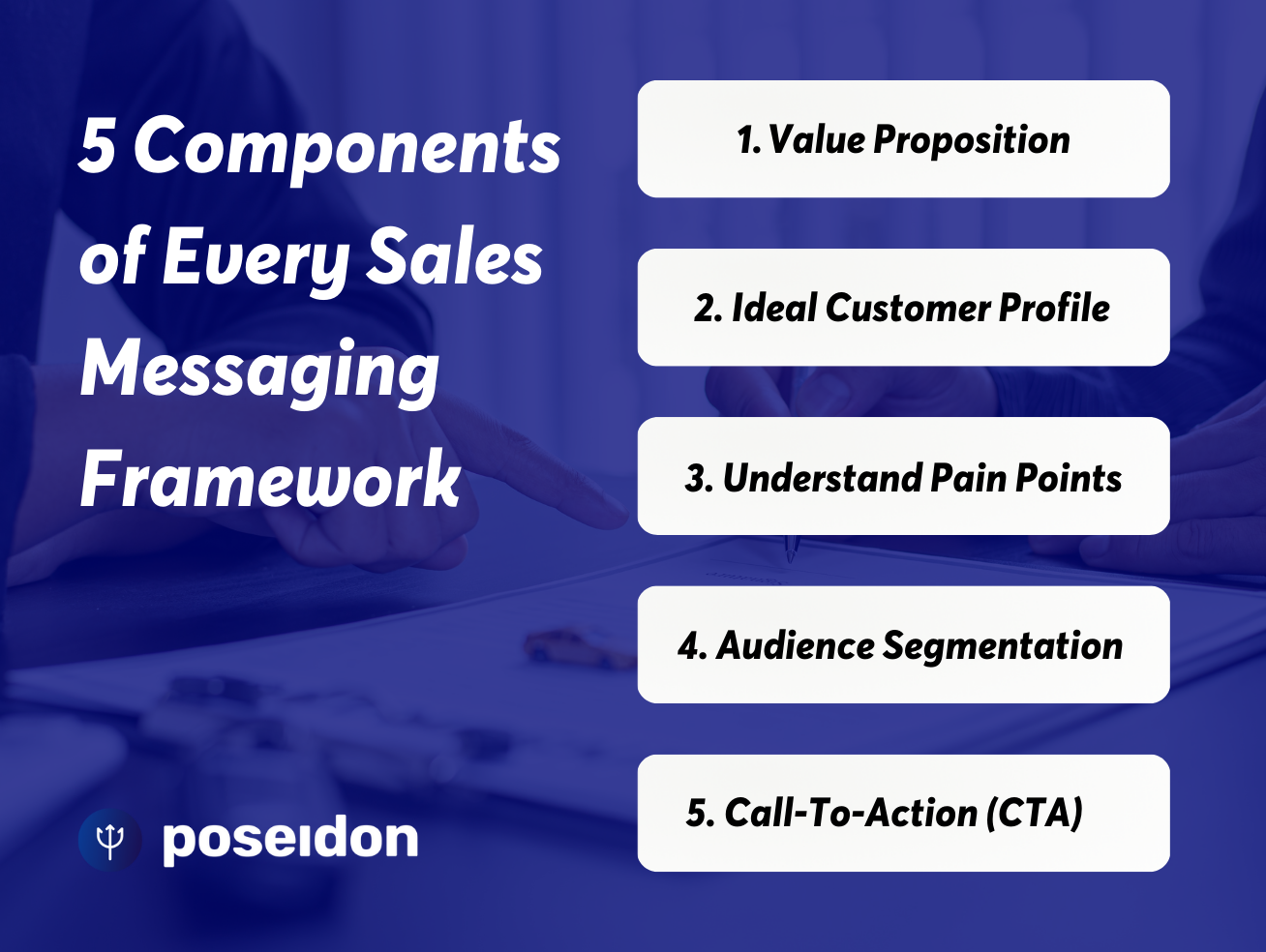Crafting effective sales messaging is a vital skill for any business looking to convert potential customers into sales.
It's the art of communicating your company's value proposition through a clear, concise, and compelling narrative. A successful sales message is not just about what you sell, but also how you sell it.
It has the power to capture attention, stimulate interest, and ultimately drive action.
Despite its significance, many companies struggle with constructing engaging and persuasive sales communications.
In this article, we will explore key strategies for creating sales messaging that resonates with your target audience, encourages engagement, and boosts sales performance.
What is a Sales Message?
A sales message is a targeted communication that conveys the value and benefits of a product or service to potential customers. It serves as a persuasive tool to influence buying decisions.
It is important for attracting and engaging prospects, building brand awareness, and ultimately driving sales.
Defining a sales message involves crafting a concise and compelling message that addresses the pain points of potential customers and demonstrates how your product or service can provide a solution.
Brand Messaging vs Sales Messaging
So what's the deal with brand messaging vs. sales messaging?
At a high level, they're related but definitely not the same thing.
Think of it this way - brand messaging is like your personality. It's about expressing what makes your business unique and valuable. Sales messaging is more like your pickup line. It's designed to grab attention and drive a specific action, like getting someone's number or going on a date.
While brand messaging might focus on your origin story or core values, sales messaging zeroes in on your product and its benefits to prospects. Good brand messaging builds a relationship over time. Sales messaging aims for a quick spark and call to action.
Both are critical, but brand messaging is about attraction while sales messaging is about persuasion.
Also Read: How to Use Ai for Sales Prospecting
5 Components that Every Sales Messaging Framework Must Have

Integrating your sales messaging strategy with your marketing messaging is crucial for a cohesive and consistent customer experience. Your marketing team should work closely with your sales team to ensure alignment and seamless communication across all channels.
To create an effective sales messaging strategy, you need to consider several key components.
1. Value Proposition
Alright, so a killer value proposition is crucial for sales messaging that converts. But what exactly should you highlight? Here's the deal - your value prop is like your superpower. It's the special sauce that makes prospects choose you over competitors.
So think about what makes you stand out.
- Do you have a unique or innovative product?
- Next-level customer service?
- A cost or efficiency advantage?
Find your X factor and make that the heart of your messaging.
Also, remember to focus on what your customers get, not just what you do. Don't just say you're an accounting software company, explain how you help businesses save 10 hours a week on reporting. Speak to their needs and frame the benefits.
Finally, keep it simple - choose one or two core differentiators and repeat them constantly. You want your value prop to stick in prospects' minds.
2. Build Your Ideal Customer Profile
When you're selling something it's important to know who you'll be selling to - aka creating your ideal customer profile.

Start by getting super clear on their demographics - think job titles, company sizes, locations, etc. Then dig into their motivations and goals. What outcomes are they trying to achieve? Where are their biggest pain points and challenges?
Also look at their buying journey - what assets or touchpoints influence their decisions?
Finally, get in their shoes mentally and emotionally. Empathize with their struggles so you can communicate in a way that shows you get them.
3. Understand Customer's Pain Points
What problems keep them up at night? Where are they struggling to find solutions?
Really dig into the specifics of their pain points across both their personal and professional lives. Look at common frustrations for people in their roles. Identify their top business objectives and problems standing in the way.
Getting clear on these struggles will allow you to position your product as the perfect remedy. You can call out the exact ways your offering alleviates their challenges and helps them achieve goals.
When your messaging is rooted in a deep understanding of their pain points, it feels relevant and tailored to their needs. This builds trust and makes you an obvious choice over generic competitors.
Their pain is the problem, your product is the cure.
Also Read: How to use Ai in Sales
4. Segment Your Audience
Alright, so chances are you have multiple customer segments with unique needs. Trying to reach all of them with one blanket message is gonna be tough.
Instead, take the time to divide and conquer. Split your audience into primary groups based on factors like demographics, behaviors, motivations, etc.
Then you can tailor and personalize messaging to align with each segment. Highlight different use cases, outcomes, or features based on their priorities.
Taking a targeted approach avoids wasting effort on generic messages that don’t fully resonate. So carve out time to strategically segment your audience. It’ll pay off big time with messaging that feels specialized for each group you want to reach.
5. A Strong Call-To-Action (CTA)
A compelling call-to-action is essential to prompt your audience to take the desired action.
This crucial element gives your prospect clear direction on their next steps.
Whether you want them to schedule a demo, start a free trial, or download educational content, be explicit. Don’t just hope they’ll take action - tell them exactly what you want them to do.
Make your CTA stand out visually on the page or email too. Use contrasting colors, buttons, or bold text so it grabs their attention. And focus on benefits they’ll get from taking action rather than features you offer.
Clearly communicate the next steps or the value of taking action, whether it's scheduling a demo, signing up for a free trial, or making a purchase.
Finally, make it stupid simple to convert. No complicated funnels. The less work for them, the better. Strong CTAs reinforce your value prop, make their decision obvious, and drive higher conversion rates.
Also Read: 4 Growth Strategies to Expand Your Customer Base
3 Tips to Develop a Good Sales Message
1. Personalize, Personalize & Personalize
To craft a compelling sales message, you need to consider several important elements. Firstly, clearly articulate the value and benefits of your product or service. This will help potential customers understand why they should choose you over your competitors.
Additionally, it is essential to personalize your sales message to resonate with your specific audience. Use the prospect's first name, show understanding of their pain points, and offer personalized solutions.
- Utilize customer testimonials
- Incorporate storytelling techniques
- Use product videos
A sales message template can serve as a starting point for crafting your message. It provides a structure that ensures you cover all the essential components while allowing for customization based on the prospect's unique needs.
2. Train Your Sales Team
Training your sales team on effective sales messaging is crucial for delivering a consistent sales message and driving successful results. Sales training helps equip your sales reps with the necessary skills and knowledge to engage potential customers and close deals.
- Provide comprehensive product or service training
- Give them easy access to sales material
- Upload all sales templates & docs to outreach tool
3. Measure the Impact
To measure the effectiveness of your sales messaging, track key metrics related to your sales process. This includes metrics such as conversion rates, average sales cycle length, and revenue generated per salesperson.
Collecting feedback from sales reps based on their experience with prospects can provide valuable insights into the effectiveness of your sales message. Regularly review and refine your sales messaging playbook based on this feedback and market trends.
Continuously improving your sales messaging playbook is essential to adapt to changing customer needs and preferences.
Common Sales Messaging Mistakes
To create effective sales messaging, it is important to avoid certain common mistakes.
Overloading your sales message with technical jargon can confuse and alienate potential customers. Use language that is easy to understand and focuses on the benefits rather than complex features.
Another mistake to avoid is not customizing your sales message for each prospect. Generic, one-size-fits-all messages are unlikely to resonate with individual needs and desires. Take the time to personalize your message and show that you understand their specific pain points.
Ignoring the role of empathy in your sales messaging can also be detrimental. Understanding and empathizing with the challenges and goals of your potential customers helps build trust and rapport, leading to more successful sales conversations.
Recommended Tools for Your Sales Productivity
Poseidon
Poseidon is one of the best AI-powered prospecting tools can take personalization to a whole new level. The power of Poseidon lies in its ability to automate and streamline prospecting efforts, saving businesses time and resources.
Through its AI capabilities, it can efficiently analyze data, generate insights, and even automate outreach campaigns, freeing up sales teams to focus on building relationships and closing deals.
FAQs on Sales Messaging Strategy
Q: Why is a good sales messaging strategy important?
A: A good sales messaging strategy is important because it helps sales representatives effectively communicate with potential customers, differentiate their product or service from competitors, and ultimately drive sales.
Q: What are the key components that every sales messaging strategy should have?
A: Every sales messaging strategy should have clear and concise messaging, an understanding of the target audience, alignment with marketing messaging, personalization, and consistency in messaging across different channels.
Q: What are the things every sales messaging strategy needs to be effective?
A: To be effective, every sales messaging strategy needs to have a deep understanding of the customer's pain points, a compelling value proposition, an understanding of the buyer's journey, and the ability to address objections effectively.
Q: How can sales enablement content support a sales messaging strategy?
A: Sales enablement content, such as case studies, testimonials, and product demos, can support a sales messaging strategy by providing sales representatives with compelling examples and proof points to back up their messaging.
Q: What is the difference between inbound and outbound sales messaging?
A: Inbound sales messaging refers to strategies that attract potential customers through content marketing, while outbound sales messaging involves directly reaching out to potential customers through cold calls or emails.
Q: How can I make my sales messaging stand out?
A: To make your sales messaging stand out, you can focus on personalization, storytelling, addressing specific pain points, and providing unique insights or solutions that differentiate your product or service from competitors.

![How to Use Ai for Sales Prospecting [Ai + Sales]](https://cdn.sanity.io/images/l79olr63/production/c38ecfe5dd01f2f27db4e2865a71e5c492aa54d6-1232x928.webp)
